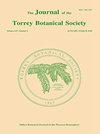寻找化感作用:加利福尼亚海岸鼠尾草灌丛和chamise chaparral的化学抑制调查的生态历史观点
IF 0.8
4区 生物学
Q4 PLANT SCIENCES
引用次数: 25
摘要
RICHARD W. HALSEY(南加州Chaparral Field Institute, Escondido, CA 92033邮政信箱545)。寻找化感作用:加利福尼亚海岸鼠尾草灌丛和chamise chaparral的化学抑制调查的生态历史观点。托里·博特。Soc》131。343 - 367。2004.植物之间的化感作用,即一种植物通过化学手段影响另一种植物,从希腊人开始就被推测出来。在二十世纪下半叶,南加州是几个有影响力的研究者化感疗法研究的焦点。Frits Went认为,一种常见的沙漠灌木,通过化学抑制作用,抑制了一年生植物在其树冠下的生长。Reed Gray和James Bonner进行了进一步的调查。Cornelius H. Muller质疑对Encelia的化感作用解释,但后来认为化学抑制是在南加州沿海鼠尾草灌丛(主要是在鼠尾草和加利福尼亚蒿周围)和束状树阴(chamise) chaparral中发现的植被模式的原因。许多研究者对穆勒的结论提出了质疑,但穆勒仍然相信化感作用是南加州灌丛地的一个重要生态变量。穆勒对他的科学模型充满激情的信仰使他忽视了相反的证据,然而他对科学的奉献和对学生的教育激励了许多人。化感作用在今天仍然是一个有争议的话题,尽管有数百项研究,因为很难分离出影响植物生长的所有可能的变量。本文章由计算机程序翻译,如有差异,请以英文原文为准。
In search of allelopathy: an eco-historical view of the investigation of chemical inhibition in California coastal sage scrub and chamise chaparral
RICHARD W. HALSEY (Southern California Chaparral Field Institute, P.O. Box 545, Escondido, CA 92033). In search of allelopathy: an eco-historical view of the investigation of chemical inhibition in California coastal sage scrub and chamise chaparral. J. Torrey Bot. Soc. 131. 343–367. 2004.—Allelopathy between plants, whereby one species influences another by chemical means, has been speculated upon since the Greeks. During the second half of the twentieth century, southern California was the focal point of allelopathic research by several influential investigators. Frits Went suggested Encelia farinosa, a common desert shrub, inhibited annuals from growing under its canopy by chemical inhibition. Reed Gray and James Bonner conducted further investigations. Cornelius H. Muller questioned the allelopathic explanation for Encelia, but later felt chemical inhibition was the cause for vegetation patterns found in both southern Californian coastal sage scrub, primarily around Salvia leucophylla and Artemisia californica, and Adenostoma fasciculatum (chamise) chaparral. Various investigators challenged Muller’s conclusions, but Muller remained convinced allelopathy was an important ecological variable in southern California’s shrublands. Muller’s passionate belief in his scientific models led him to ignore contrary evidence, yet his dedication to science and the education of his students inspired many. Allelopathy remains a controversial topic today despite hundreds of investigations because of the difficulty in isolating all the possible variables affecting plant growth.
求助全文
通过发布文献求助,成功后即可免费获取论文全文。
去求助
来源期刊
CiteScore
0.70
自引率
0.00%
发文量
16
审稿时长
>12 weeks
期刊介绍:
The Journal of the Torrey Botanical Society (until 1997 the Bulletin of the Torrey Botanical Club), the oldest botanical journal in the Americas, has as its primary goal the dissemination of scientific knowledge about plants (including thallopyhtes and fungi). It publishes basic research in all areas of plant biology, except horticulture, with an emphasis on research done in, and about plants of, the Western Hemisphere.

 求助内容:
求助内容: 应助结果提醒方式:
应助结果提醒方式:


